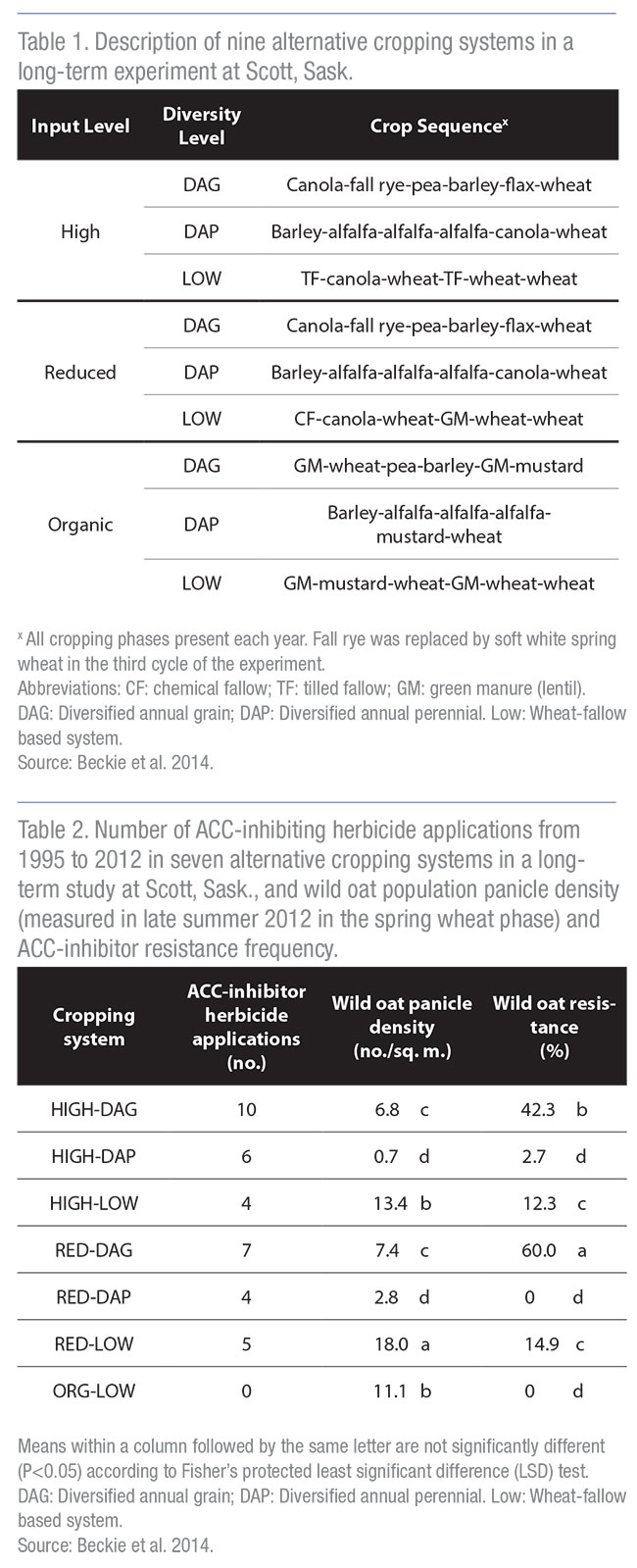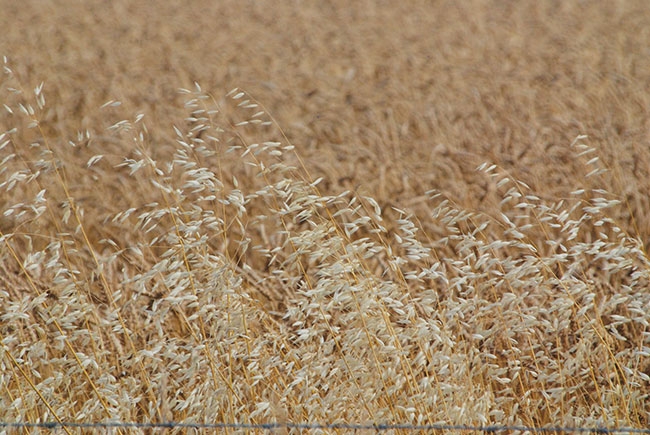
Features
Agronomy
Genetics/Traits
A case study in Group 1 herbicide resistance
This story is about what not to do. A long-term cropping study shows how acetyl-CoA carboxylase (ACC) inhibitors (Group 1) wild oat resistance can develop.
Group 1 resistance was first discovered in 1984 in Saskatchewan and has steadily grown over the last 30 years. The most recent surveys of herbicide-resistant weeds was conducted in Alberta in 2007, Manitoba in 2008 and Saskatchewan in 2009, covering 1000 randomly-selected, annually-cropped fields led by research scientist Hugh Beckie and his colleagues at Agriculture and Agri-Food Canada (AAFC) at the Saskatoon Research Station. Group 1-resistant wild oats were found on 44 per cent of fields where wild oats were sampled, up from 15 per cent from 2001–2003 baseline surveys.
“There isn’t any reason to doubt that the numbers aren’t continuing to grow,” Beckie says.
In an effort to better understand how Group 1 wild oat herbicide resistance develops, Beckie looked at a long-term crop rotation study that was established at the Scott, Sask. AAFC research farm in 1995. Three different input types were used in three different levels of crop diversity. High-input systems used pesticides and fertilizers based on accepted agronomic recommendations. Reduced input systems used an integrated pest management and nutrient approach, supplemented by chemicals. The third system was an organic system based on non-chemical pest control and nutrient management.
The first six-year crop sequence cycle was conducted from 1995 to 2000, the second cycle from 2001 to 2006, and the third cycle from 2007 to 2012 (see Table 1).
In August 2012, wild oat seed density was measured and seed was collected for screening for Group 1 herbicide resistance. Over the winter, the seed was tested for Group 1 resistance with the Group 1 herbicides fenoxaprop (Puma) and sethoxydim (Poast). The results provide insight into how Group 1 resistance develops and what growers can do to slow the development of resistance.
Beckie says the resistance level to fenoxaprop was greatest in the reduced input/diversified annual grain and high input/diversified annual grain systems. The diversified annual grain (DAG) cropping systems had the most Group 1 herbicide treatments with 10 applications in the high input system and seven in the reduced DAG system over the 18-year period. These applications were mainly in cereals, barley and wheat, but also could have included the flax cropping years as well.
The reduced input/high diversity cropping system had the highest frequency of wild oat resistance at 60 per cent. The high input/high diversity cropping system also had very high levels of wild oat resistance at 42 per cent. However, when a short-term perennial crop was included in both high and reduced input systems, the presence of wild oat resistance was dramatically lower. Organic systems did not have any wild oat resistance, which was expected because of the lack of herbicide selection pressure. (See Table 2.)
“We certainly know that including a perennial crop in the rotation will slow the development of resistance because herbicide use is reduced and seed production of annual weeds is suppressed,” Beckie explains. “The difficulty for farmers is with the integration and profitability of perennial crops.”
One interesting finding was that no wild oat resistance was found to sethoxydim. This active ingredient is also a Group 1 herbicide but in a different subgroup than fenoxaprop. Within Group 1, there are three chemical families commonly called the fops, dims and dens. Weed populations may evolve to be resistant to one subgroup but not another, but may also evolve to be resistant to all subgroups.
“I was a little surprised to see that the wild oats weren’t resistant to both fenoxaprop and sethoxydim. We looked at the target site mutation and it only conferred resistance to the fops,” Beckie explains, adding the explanation may be as simple as that Hoe-Grass (diclofop-methyl) had been used as far back as 1976, and that the fop selection pressure had a longer history on the wild oat population at the site.
“In a case like this, a farmer can be lucky in that only the fops had developed resistance and he still has the dims and dens left to use,” Beckie says. “I advise farmers that if they have suspected fop resistance and they still want to use a Group 1 herbicide, try the other classes in the group. It is a short term strategy but may work for a while.”
Beckie also says the research shows that just including a diversified annual cropping rotation isn’t enough to head off herbicide resistance, because it may not have enough herbicide diversity. He explains that based on grower surveys from 2006 through 2010, Group 1 herbicides were applied to 100 per cent of flax acres, 86 per cent of barley, 76 per cent of wheat, 44 per cent of lentil and 24 per cent of pea.
Good herbicide resistance management includes not only herbicide rotation but also “real” crop diversity and herbicide use reduction through the use of perennial crops or cover/green manure crops.
“We need to be careful when we define cropping diversity. In Western Canada we mostly have annual spring seeded, cool-season crops. Even with this diversity it helps, but it isn’t really cropping diversity. What we need is some diversity between spring- and fall-seeded crops, green manure/cover crop versus chemical fallowing if possible, and using perennial crops. Those types of diverse rotations help reduce selection pressure,” Beckie says. “Perennial cereal crops would make a big dent in herbicide resistant management if or when they are commercialized.”

March 4, 2015 By Bruce Barker
 Diversity in spring/fall crops A long-term cropping study shows how acetyl-CoA carboxylase (ACC) inhibitors (Group 1) wild oat resistance can develop.
Diversity in spring/fall crops A long-term cropping study shows how acetyl-CoA carboxylase (ACC) inhibitors (Group 1) wild oat resistance can develop.